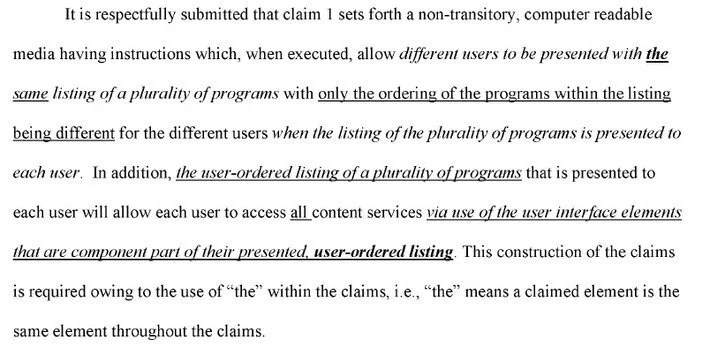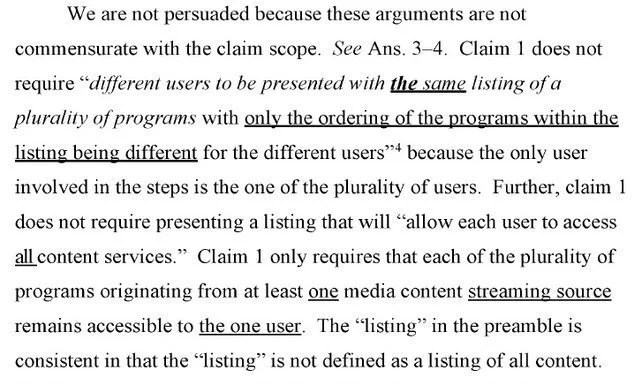When drafting persuasive papers, such as responses to Office actions or appeal briefs, the applicant is relying on the written word to get their point across. While pictures and diagrams are a great way to supplement written arguments, there is always a question about when and how, if at all, to use emphasis (bold, underlined, all caps, italics, etc.).
This post does not attempt to answer these complex questions, but rather points out a potential pitfall in using emphasis in patent prosecution arguments. In particular, using emphasized language on a point that is open to attack can cause the emphasis on the problems with the argument. A recent appeal at the PTAB illustrates the issue when the applicant uses emphasis in a way that can be characterized as running afoul of Judge Rich’s golden rule that “the name of the game is the claim.”
The case is 16/800,787, Appeal 2022-001373.
The invention relates to a system and method for a self adaptive multi-user program guide, including improved methods for display of media content listings such as program guides and/or DVR directories. Claim 1 is reproduced below:
1. A non-transitory, computer readable media having stored thereon instructions which, when executed by a processing device of a digital media receiver, cause the digital media receiver to perform steps for displaying a listing of a plurality of programs originating from at least one media content streaming source comprising:
receiving from a one of a plurality of users a request to display the listing of the plurality of programs; and
in response to the request, causing the listing of the plurality of programs to be displayed on a display device associated with the digital media receiver with the listing of the plurality of programs being displayed with a priority order that is specific to the one of the plurality of users;
wherein the priority order that is specific to the one of the plurality of users is determined as a function of a viewing history data associated with the one of the plurality of users, the listing of the plurality of programs as displayed on the display device comprises a graphical user interface for use in causing a select one of the plurality of programs to be displayed on the display device, and each of the plurality of programs originating from at least one media content streaming source remains accessible to the one of the plurality of users via use of the graphical user interface
At issue in the appeal was whether the prior art showed all claim elements in the context of Section 102 based on a reference called Schneidewend. The applicant argued that the reference was deficient in terms of the listing of programs. The appeal brief introduced the argument as follows:

As illustrated, the applicant utilized various combinations of underlining, bolding, and italicizing providing a stratification of emphasis. And while this introductory paragraph does not appear intended to be the primary argument against the cited references (but rather was presented more as an introductory paragraph), it nevertheless paraphrased elements of claim 1 and was presented as being what was”set forth” in claim 1. It is always dangerous to paraphrase claim elements, and even more so when using emphasis. It gives the other side (or the PTAB) the ability to focus right in on what has been emphasized as having a fundamental flaw. Here – that flaw is that claim 1 did not actually require the paraphrased language. The PTAB jumped on the emphasized language and used it to undercut the applicant’s arguments:

This is not to say that the emphasizing caused a negative result here. However, the PTAB was able to make what seems like a strong point by pointing out an alleged flaw in the very argument emphasized by the appellant. This is the danger of emphasizing.
It can be prudent to be careful with emphasizing parts of an argument. If the other side can find a flaw with the emphasized part, it can make the overall argument seem flawed.
So, be careful with emphasizing. It can be dangerous to emphasize language in a way that the other side can use the emphasis to their advantage.

Leave a comment